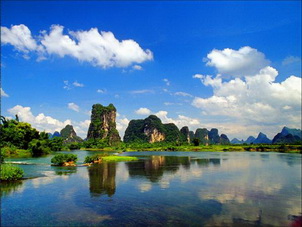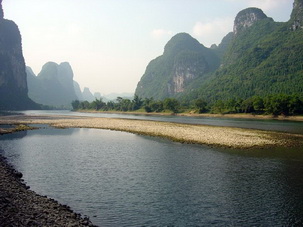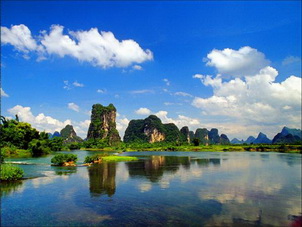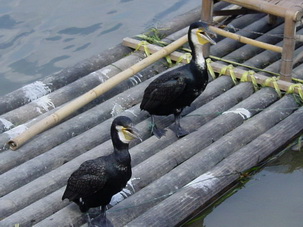 Li River, also known as Guishui River or Gui River, takes its source at Mao'er Mountain in Xing'an County, which lies to northeast Guilin, Guangxi Zhuang Autonomous Region. Li River makes its way through Guilin and Yangshuo and merges into Xijiang River in Wuzhou. The mountains on the banks over 40 kilometers long between Guilin and Yangshuo display their extraordinary beauty as a result of the development of the limestone. More than 40,000 hills lie along the two sides of the river, covering a total length of more than 150 kilometers.
Li River, also known as Guishui River or Gui River, takes its source at Mao'er Mountain in Xing'an County, which lies to northeast Guilin, Guangxi Zhuang Autonomous Region. Li River makes its way through Guilin and Yangshuo and merges into Xijiang River in Wuzhou. The mountains on the banks over 40 kilometers long between Guilin and Yangshuo display their extraordinary beauty as a result of the development of the limestone. More than 40,000 hills lie along the two sides of the river, covering a total length of more than 150 kilometers.
With their astonishing resemblance to bamboo shoot, screen, elephant and camel, these mountains, together with green banyans and green bamboo as well as the cottages and fishing boats, contribute to form a scenery picture depicting a haven of peace dominated by green. It has a total length of more than 430 kilometers. In the past it was thought that Li River shares the same source with Xiangjiang River. A watershed divides the two rivers, one flowing to the north and the other to the .south. Li River meanders southward like a belt flanked by mountains and marvelous peaks. The 83-kilometre- long waterway from Guilin to Yangshuo is especially spectacular. Cruising on this section of the river the tourist feels very poetic. The town of Xingping is located at a bend of Li River down in the south. Cruising 13 kilometers upstream from here, the tourist will find the most beautiful scenery of Li River. The nearby mountains resemble green screens while the remote mountains seem to be in smoky mist, and their inverted reflection in water are blackish green. Even the air seems to have been tinged with green. Green is the essence of the beauty of Guilin. The Li River was an exceptional place to observe the native farmers as they go about their daily routines. There was much people activity all along the river. Farmers tilling land, duck herders watching over their flocks, people washing laundry in the river, fishermen and much more. Another special treat was seeing so many water buffalo.







 China Tours
China Tours Tibet Tours
Tibet Tours China Theme Tours
China Theme Tours Off The Beaten Track
Off The Beaten Track Yangtze Cruises
Yangtze Cruises China Trip Planner
China Trip Planner Travel Agents
Travel Agents China Tours
China Tours Tibet Tours
Tibet Tours China Theme Tours
China Theme Tours Off The Beaten Track
Off The Beaten Track Yangtze Cruises
Yangtze Cruises China Trip Planner
China Trip Planner Travel Agents
Travel Agents


 0086-28-85711328
0086-28-85711328 0086-28-85546015
0086-28-85546015




 Li River, also known as Guishui River or Gui River, takes its source at Mao'er Mountain in Xing'an County, which lies to northeast Guilin, Guangxi Zhuang Autonomous Region. Li River makes its way through Guilin and Yangshuo and merges into Xijiang River in Wuzhou. The mountains on the banks over 40 kilometers long between Guilin and Yangshuo display their extraordinary beauty as a result of the development of the limestone. More than 40,000 hills lie along the two sides of the river, covering a total length of more than 150 kilometers.
Li River, also known as Guishui River or Gui River, takes its source at Mao'er Mountain in Xing'an County, which lies to northeast Guilin, Guangxi Zhuang Autonomous Region. Li River makes its way through Guilin and Yangshuo and merges into Xijiang River in Wuzhou. The mountains on the banks over 40 kilometers long between Guilin and Yangshuo display their extraordinary beauty as a result of the development of the limestone. More than 40,000 hills lie along the two sides of the river, covering a total length of more than 150 kilometers.




